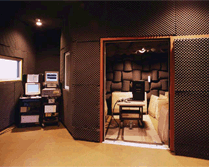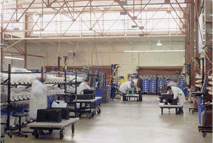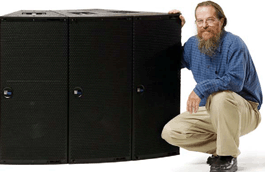The new JM-1P arrayable loudspeaker from Meyer Sound Laboratories rather neatly encapsulates the company’s 30-year history. This is a product that returns to the fundamentals of single point source speaker design, while refining the concept with the benefit of three decades of research and a long list of patented technologies.
John Meyer began experimenting with single point source systems shortly before he co-founded Meyer Sound in February 1979 with his wife, Helen. As he observes, people are used to hearing a single point source in a reverberant space when talking to each other. Yet in the 1970s, stadiums and other large venues employed distributed systems— and, indeed, still do to this day. “From those multiple sources you got multiple echoes,” he pointed out.
Meyer Sound founder John Meyer’s namesake, the JM-1P system, “reclaims the horizontal” in applications where a line array may not be the most convenient or the best solution.
In an experiment conducted at a local Bay Area Rapid Transit station shortly before establishing Meyer Sound, using a speaker left over from a previous venture, Glyph Sound Systems, he recalls that it outperformed the distributed system. “We found that we could get better intelligibility from one speaker than we could from all the little multiple point sources that they were using.”
But technology, especially horn design, was not yet up to the task of enabling arrays to successfully behave like a point source: “[The horns] would interact with one another and you’d get some smear, because horns are more like floodlights than perfectly coherent spotlights.” For example, early horns such as Altec’s Manta Ray offered directional control, but the frequency response looked like a comb filter, he said, due to the echo structure in the horn itself. Acoustical lenses had the same problem, in that they controlled the sound but introduced comb-filtering effects.

Three decades of research and a long list of patented technologies are combined in the JM-1P.
But, he continued, “Throughout the years of developing programs and doing experiments we slowly started to make some progress in controlling the sound in a horn more accurately without secondary problems.” Indeed, the very first of many patents issued to the company, in 1979, was for a horn design that significantly reduced distortion. That design was applied to the company’s first product, the UM-1 UltraMonitor.
The next product from the company sought to obtain more power out of a system by tightly arraying cabinets. By adopting a non-rectangular design they could also behave as a point source when arrayed next to each other. That product, the UPA- 1 (essentially a repackaging of the UM-1 into a compact, wide coverage speaker), introduced the industry to the trapezoidal cabinet, a design that was granted the company’s second patent, in 1983, and further set the foundation for the JM-1P.
But first Meyer Sound needed to further refine horn pattern control and performance. That came with the REM or ribbon emulation manifold, patented in 2003, in which, he explained, “You were basically building a high-resolution line array inside the horn.”
The trapezoid box and the various horn developments over the years were all part of an effort to refine the single point source system. “It’s been a long quest to find all this technology,” Meyer said. As the company pondered a modern replacement in its product line for the classic MSL-4 (the company’s first self-powered system, introduced in 1995), word from the field was that customers were looking for something light, wide range, and with easy-to-use captive rigging, he reported. “We thought, maybe this is the opportunity to combine all this technology.”

Product development comes to fruition at Meyer’s Berkeley, CA headquarters.
The result, the JM-1P, is a system that, according to Meyer Sound’s publicity materials, “reclaims the horizontal.” Appropriate for use where a line array may not be the most convenient or the best solution, the JM-1P offers all the advantages of a tight-pack array in applications that require precise horizontal control, such as theaters and houses of worship, or to provide side or center fill in a larger setup.
Using the company’s patented horn technologies, most notably the REM, Meyer has limited horizontal coverage of the JM-1P’s horn to a precise 20 degrees. “It had never really been tried before, putting things next to each other without them interfering with each other,” he says. “So we thought this would be interesting to try, if for no other reason than you could just add these things together simply. If you add three together you get 60 degrees; four, you get 80 degrees.”
It remains to be seen if the market is ready to adopt the single point source concept. As Meyer noted, “People are still putting all kinds of speakers throughout these spaces. We’re not there yet in terms of everyone realizing what it is that we need.” But as demonstrations of the JM-1P have shown, he said, “It’s simpler and easier to understand, and easier to hear things when someone is talking. It’s hard to describe exactly, but it’s more like what you think sound should be like.”
